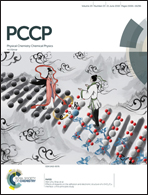Detection of simple inorganic and organic molecules over Cu-decorated circumcoronene: a combined DFT and QTAIM study†
Abstract
Nowadays graphene materials have attracted a considerable attention because of their potential utilization as gas sensors, biosensors, or adsorbents. Doping or decorating the graphene surface with transition metals can significantly tune its electronic properties and chemical reactivity. Circumcoronene, being a polyaromatic hydrocarbon composed of 19 benzene rings, can be used as a model system of a tiny graphene quantum dot. The adsorption of a set of small molecules (water, hydrogen peroxide, methanol, ethanol, and oxygen) over the copper-decorated circumcoronene was theoretically investigated using density functional theory (DFT) and Bader's quantum theory of atoms in molecules (QTAIM). Following the obtained B3LYP energies, the adsorption of O2 and the chemisorption of H2O2 were found to be energetically the most favorable, with energetic outcomes of −3.6 eV and −3.7 eV, respectively. Moreover, an H2O2 molecule was decomposed during the chemisorption on the Cu atom to form a neutral Cu(OH)2 molecule. Changes in the electronic structure of the studied systems, in particular the oxidation of copper, after the adsorption were investigated within the framework of QTAIM (e.g., charges, bond critical points, and delocalization indices) and partial density of states (PDOS) analysis. The results of this study suggest the suitability of the Cu-decorated graphene materials as adsorbents and/or gas sensors in practical applications.



 Please wait while we load your content...
Please wait while we load your content...